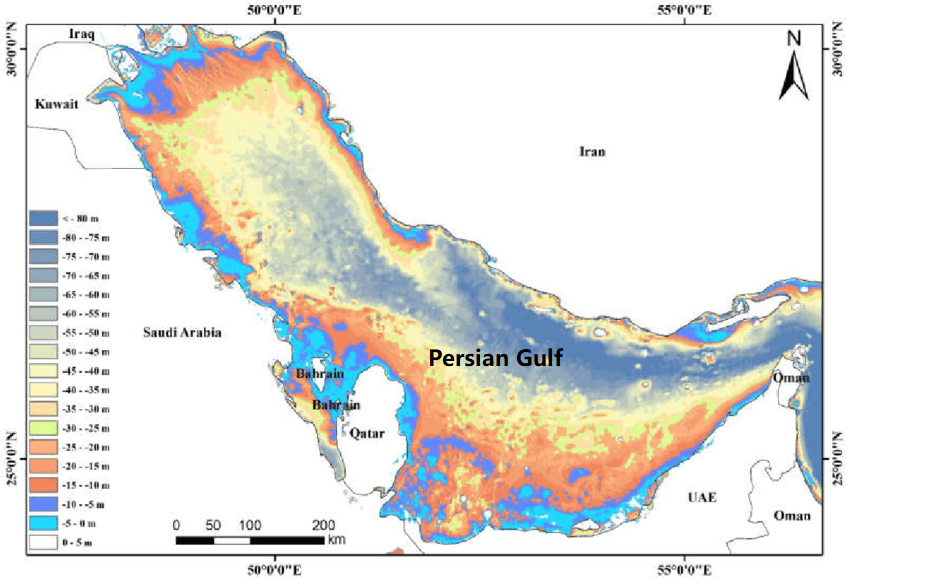Introduction
The Persian Gulf, a strategic and historically significant body of water, has long been a center of geopolitical interest due to its extensive oil reserves and prime location between the Arabian Peninsula and Iran. Covering an area of approximately 251,000 square kilometers (96,912 square miles), the gulf stretches about 990 kilometers (615 miles) from the Shatt al-Arab river delta in the northwest to the Strait of Hormuz in the southeast. In this article, we delve into the varying depths of the Persian Gulf, exploring its unique geography and its implications for regional and global maritime activities.
Geographical Overview
The Persian Gulf is a semi-enclosed, shallow, marginal sea, with an average depth of around 50 meters (164 feet) and a maximum depth of approximately 110 meters (361 feet) in its central basin. The gulf’s waters are generally shallow, with over 60% of the area being less than 30 meters (98 feet) deep. This shallow nature has significant consequences for navigation, marine life, and the extraction of resources such as oil and natural gas.
Depth Distribution in the Persian Gulf
The Persian Gulf’s depth varies significantly across its different regions, with notable differences between the Arabian and Iranian coasts. The following is a breakdown of the gulf’s depth in various areas:
- Northwestern region (Shatt al-Arab delta): The gulf’s depth is at its shallowest near the Shatt al-Arab delta, with depths ranging from 2 meters (6.5 feet) to 10 meters (32.8 feet). This region is characterized by its extensive marshlands and riverine deposits from the Tigris and Euphrates rivers.
- Arabian Coast: Along the Arabian coast, the gulf’s depth is relatively shallow, ranging from 10 meters (32.8 feet) to 40 meters (131 feet). The coastal waters are characterized by extensive sandbars, shoals, and coral reefs, which are home to diverse marine ecosystems. Major ports, such as Dammam in Saudi Arabia, have been dredged to accommodate large vessels.
- Iranian Coast: The Iranian coast is generally deeper than the Arabian coast, with depths ranging from 30 meters (98 feet) to 70 meters (230 feet). This region is marked by a series of narrow coastal plains and the Zagros Mountain range, which influence the topography of the seabed.
- Central Basin: The deepest part of the Persian Gulf lies in its central basin, with depths reaching up to 110 meters (361 feet). This area is of particular importance for the extraction of oil and natural gas resources, as well as for the development of artificial islands for drilling and production facilities.
Implications of Depth Variations
The varying depths of the Persian Gulf have several important implications for maritime activities, including shipping, fishing, and resource extraction:
- Shipping and navigation: The gulf’s shallow waters pose challenges for the navigation of large vessels, particularly oil tankers. Many ports have been dredged and deepened to accommodate these ships, and navigational aids such as buoys, beacons, and electronic charting systems are critical to ensure safe passage.
- Fishing and marine life: The shallow waters along the Arabian coast provide ideal habitats for diverse marine ecosystems, including coral reefs, seagrass beds, and mangroves. These areas are essential for the gulf’s fisheries, which are a vital source of food and income for the region’s coastal communities.
- Oil and natural gas extraction: The Persian Gulf is home to some of the world’s largest oil and gas reserves, and the depth of its waters plays a crucial role in

